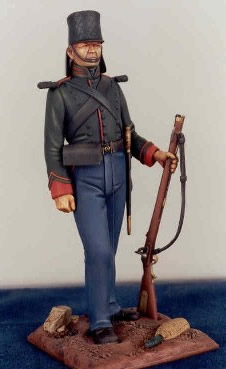- Store
- >
- 100mm figures
- >
- TLB 012 100mm Pvt Kings Royal Rifles 1848
TLB 012 100mm Pvt Kings Royal Rifles 1848
SKU:
$35.95
$35.95
Unavailable
per item
The Sikh War, 1848-1849.
Punjaub, 1848-49. The province of Mooltan had been only two years under British rule. The two British emissaries who had been sent in April 1848, to support the new Sikh Governor were murdered and the whole of the Western Punjaub broke into revolt, backed by the Ameer of Afghanistan. By the end of the year sufficient troops were assembled and operations began.
Mooltan. Was invested on 27th December and taken by assault on 21st January 1849. The 1st Battalion, under the command of Major M.G. Davis (Lieutenant-Colonel Dundas having been given command of a division), covered the advance and lost 11 killed and 31 wounded during the siege. It then marched to join the army under Lord Gough.(afterwards Field-Marshal Viscount Gough, K.P., K.C.B., G.C.S.I., Colonel-in-Chief, 1854-69)
Goojerat, 21st February 1849. At Goojerat Lord Gough gained a complete victory over a force of 60,000 Sikhs and Afghans, capturing 53 guns. Lieutenant-Colonel J Bradshaw commanded the 1st Battalion in this battle, after which he was given a brigade and Major Davis resumed command. A vigorous pursuit followed. Sixteen thousand of the enemy surrendered at Rawl Pindi with 41 guns. The Afghans were followed up as far as the Khyber Pass, which was reached on 18th March. The Battalion had marched 496 miles since 3rd February.
"Nothing could exceed the gallantry and discipline of the 60th Royal Rifles" were the words of the Gazette.
Punjaub, 1848-49. The province of Mooltan had been only two years under British rule. The two British emissaries who had been sent in April 1848, to support the new Sikh Governor were murdered and the whole of the Western Punjaub broke into revolt, backed by the Ameer of Afghanistan. By the end of the year sufficient troops were assembled and operations began.
Mooltan. Was invested on 27th December and taken by assault on 21st January 1849. The 1st Battalion, under the command of Major M.G. Davis (Lieutenant-Colonel Dundas having been given command of a division), covered the advance and lost 11 killed and 31 wounded during the siege. It then marched to join the army under Lord Gough.(afterwards Field-Marshal Viscount Gough, K.P., K.C.B., G.C.S.I., Colonel-in-Chief, 1854-69)
Goojerat, 21st February 1849. At Goojerat Lord Gough gained a complete victory over a force of 60,000 Sikhs and Afghans, capturing 53 guns. Lieutenant-Colonel J Bradshaw commanded the 1st Battalion in this battle, after which he was given a brigade and Major Davis resumed command. A vigorous pursuit followed. Sixteen thousand of the enemy surrendered at Rawl Pindi with 41 guns. The Afghans were followed up as far as the Khyber Pass, which was reached on 18th March. The Battalion had marched 496 miles since 3rd February.
"Nothing could exceed the gallantry and discipline of the 60th Royal Rifles" were the words of the Gazette.
